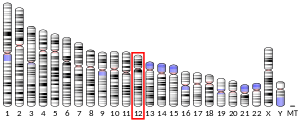TAS2R50
Taste receptor type 2 member 50 is a protein that in humans is encoded by the TAS2R50 gene.[3][4][5][6]
| TAS2R50 | |||||||||||||||||||||||||
|---|---|---|---|---|---|---|---|---|---|---|---|---|---|---|---|---|---|---|---|---|---|---|---|---|---|
| Identifiers | |||||||||||||||||||||||||
| Aliases | TAS2R50, T2R50, T2R51, TAS2R51, taste 2 receptor member 50 | ||||||||||||||||||||||||
| External IDs | OMIM: 609627 HomoloGene: 88474 GeneCards: TAS2R50 | ||||||||||||||||||||||||
| |||||||||||||||||||||||||
| Orthologs | |||||||||||||||||||||||||
| Species | Human | Mouse | |||||||||||||||||||||||
| Entrez |
| ||||||||||||||||||||||||
| Ensembl |
| ||||||||||||||||||||||||
| UniProt |
| ||||||||||||||||||||||||
| RefSeq (mRNA) |
| ||||||||||||||||||||||||
| RefSeq (protein) |
| ||||||||||||||||||||||||
| Location (UCSC) | Chr 12: 10.99 – 10.99 Mb | n/a | |||||||||||||||||||||||
| PubMed search | [2] | n/a | |||||||||||||||||||||||
| Wikidata | |||||||||||||||||||||||||
| |||||||||||||||||||||||||
Function
TAS2R50 belongs to the large TAS2R receptor family. TAS2Rs are expressed on the surface of taste receptor cells and mediate the perception of bitterness through a G protein-coupled second messenger pathway.[4] See also TAS2R10.[6]
gollark: dot. dot. dot. potatOS tau.
gollark: Do you want to possibly increase the damage a security issue might do?
gollark: Then why run it as root? WHY?
gollark: Run as little as possible as root, even.
gollark: Just don't run networked applications as root.
See also
References
- ENSG00000276167, ENSG00000273431 GRCh38: Ensembl release 89: ENSG00000212126, ENSG00000276167, ENSG00000273431 - Ensembl, May 2017
- "Human PubMed Reference:". National Center for Biotechnology Information, U.S. National Library of Medicine.
- Bufe B, Hofmann T, Krautwurst D, Raguse JD, Meyerhof W (Oct 2002). "The human TAS2R16 receptor mediates bitter taste in response to beta-glucopyranosides". Nat Genet. 32 (3): 397–401. doi:10.1038/ng1014. PMID 12379855.
- Conte C, Ebeling M, Marcuz A, Nef P, Andres-Barquin PJ (Feb 2003). "Identification and characterization of human taste receptor genes belonging to the TAS2R family". Cytogenet Genome Res. 98 (1): 45–53. doi:10.1159/000068546. PMID 12584440.
- Shiffman D, Ellis SG, Rowland CM, Malloy MJ, Luke MM, Iakoubova OA, Pullinger CR, Cassano J, Aouizerat BE, Fenwick RG, Reitz RE, Catanese JJ, Leong DU, Zellner C, Sninsky JJ, Topol EJ, Devlin JJ, Kane JP (Sep 2005). "Identification of Four Gene Variants Associated with Myocardial Infarction". Am J Hum Genet. 77 (4): 596–605. doi:10.1086/491674. PMC 1275608. PMID 16175505.
- "Entrez Gene: TAS2R50 taste receptor, type 2, member 50".
Further reading
- Margolskee RF (2002). "Molecular mechanisms of bitter and sweet taste transduction". J. Biol. Chem. 277 (1): 1–4. doi:10.1074/jbc.R100054200. PMID 11696554.
- Montmayeur JP, Matsunami H (2002). "Receptors for bitter and sweet taste". Curr. Opin. Neurobiol. 12 (4): 366–71. doi:10.1016/S0959-4388(02)00345-8. PMID 12139982.
- Zhang Y, Hoon MA, Chandrashekar J, Mueller KL, Cook B, Wu D, Zuker CS, Ryba NJ (2003). "Coding of sweet, bitter, and umami tastes: different receptor cells sharing similar signaling pathways". Cell. 112 (3): 293–301. doi:10.1016/S0092-8674(03)00071-0. PMID 12581520.
- Fischer A, Gilad Y, Man O, Pääbo S (2005). "Evolution of bitter taste receptors in humans and apes". Mol. Biol. Evol. 22 (3): 432–6. doi:10.1093/molbev/msi027. PMID 15496549.
- Go Y, Satta Y, Takenaka O, Takahata N (2006). "Lineage-Specific Loss of Function of Bitter Taste Receptor Genes in Humans and Nonhuman Primates". Genetics. 170 (1): 313–26. doi:10.1534/genetics.104.037523. PMC 1449719. PMID 15744053.
This article incorporates text from the United States National Library of Medicine, which is in the public domain.
This article is issued from Wikipedia. The text is licensed under Creative Commons - Attribution - Sharealike. Additional terms may apply for the media files.

